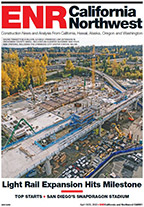China rang in the new year by announcing plans to increase its high-speed railway service by 50%—to 30,000 kilometers from the present level of 20,000 kms—by 2020. The country already already claims 65% of the world's high-speed rail trackage.
The world's longest high-speed rail link, which covers 2,252 km to connect the cities of Shanghai and Kunming, began service on Dec. 28. The train cuts the journey from 35 hours to 11 hours while passing through five provinces of Zhejiang, Jiangxi, Hunan, Guizhou and Yunnan, China Railway Corp. said. Work on another high-speed rail line linking Kunming and Nanning cities was also launched.
Beijing authorities have announced that the city's first magnetic levitation technology line will start running in 2017. Testing of new trains has already begun.
The system’s initial overhead maglev line, named S1, will cover 10 km and eight stations. The city will have 10 such trains, each capable of transporting 1,000 passengers. Construction work began in 2011 amid some public debate about the risks involved.
"The line employs closed magnetic field technology that elevates the train about 1 cm above the track to reduce friction. It leaks no magnetic influence outside the controlling 'red line' distance, therefore it won't affect nearby residents," Li Jie, chief engineer of the maglev project, told Beijing Daily. "As for passengers inside the train, as the radiation is non-ionizing like radio waves, it's neither accumulative nor harmful. At most, passengers may feel a bit warmer."
The year 2015 also closed with other notable developments for Chinese railway companies. A freight train connecting the southern Chinese city of Yiwu to London was launched. The train will traverse 12,000 km, passing through Kazakhstan, Russia, Belarus, Poland, Germany, Belgium and France, before reaching London after 18 days.
In another move, a subsidiary of the Chinese train maker, CRRC Corp. sold three high-speed rail trains to the Czech Republic for $20.8 million. This is the first time that a Chinese company has been able to cut such a deal with a member of the European Union. The company expects to see 30 trains of 160 kph operational speed in the next three years.
China's grandiose railway plan involves investing $503 billion to create 30,000 kms of additional track including 10,000 of high speed rail by 2020. The country laid the same number of track kms between 2011 and 2015. "By 2020, more than 80% of China's major cities will be connected by high-speed railways," Yang Yudong, vice-minister of transportation said while releasing a white paper, "Development of China's Transport.” By 2025, China plans to have a total of 38,000 km of high-speed track. Yang said there are some challenges in laying high-speed track in less developed western Chinese provinces that do not offer sufficient return on capital invested.
"But, building high-speed railway in less-developed regions is not only about recouping investment. It is part of the big project of rejuvenating the whole region and the country's economy," said Yang.
The country now has 124,000 km of tracks of varying speeds. The National Development Reforms Commission has envisioned total network to grow up to 175,000 km by 2025.
Analysts are asking if it makes business sense for China to invest heavily in high-speed railway and inter-city networks. Zhao Jian, a professor at the School of Economics and Management at Beijing Jiaotong University, questioned the wisdom of spending $35 billion on a network connecting Beijing and Tianjin cities because the region has more than enough railway density.
Railway experts point out that it took four years for the Beijing-Shanghai high-speed rail to become profitable. Most of the high-speed bullet trains running in less populated and less prosperous areas are losing money. Yang has countered this argument saying, “Whether it is high-speed rail or normal trains, these are all-important infrastructure projects.” He expressed confidence that the high-speed rail projects in the country’s hinterland will eventually turn a profit.
In 2017, China will spend the same amount on railway development that it did in 2014 and 2015, $115 billion. This is seen by many as good news because the country has been going through a major economic slowdown, and many of the industries that move freight via rail have seen severe production cutbacks.
The actual investments may be larger than budgetary allocation this year and the coming years. Beijing recently broke with precedent by inviting private companies to invest in two railway infrastructure projects, and opened up the railway equipment manufacturing sector to foreign investors.
The first public-private partnership (PPP) took place in the railway sector on December 23. It involved 269-km long Hangzhou-Taizhou Intercity Passenger Line worth $6.46 billion. Three Chinese companies including two auto makers took a 51% stake in the project.
Chinese officials said they will use the PPP model extensively to add new high-speed rail and to supplement government investments. The introduction of the PPP model is also meant to attract bank financing, which has so far shied away from the government controlled business. Bank financing would initially be of the order of 20-30% of project cost before it is enlarged. The government is still trying to develop a suitable revenue model that will assure financiers about timely repayment of loans and interest, sources said.



Post a comment to this article
Report Abusive Comment